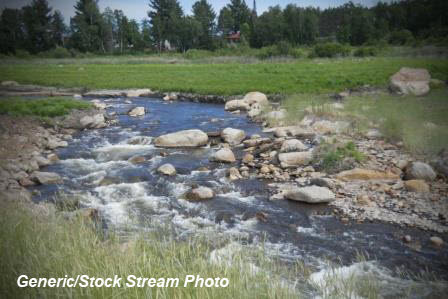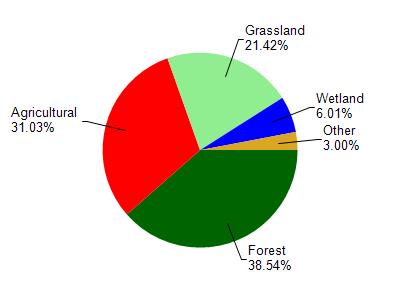
3.74 Miles
2.14 - 5.88
Macroinvertebrate, Cool-Cold Headwater, Coldwater
2025
Poor
Degraded Biological Community
Total Phosphorus
Trempealeau
Yes
No
Yes
Fish and Aquatic Life
Overview
This stream has apparently suffered significant detrimental impact from both point and nonpoint sources of pollution. A G Coop Creamery has three WPDES permitted discharges to the stream. Two of these discharges are limited to non contact cooling water (NCCW) while the third discharge includes both non contact cooling water and condensate of whey (COW) .
Fisheries Management staff observed a milky colored discharge to the stream in August of 1988 near A G Coop Creamery. This discharge came from a permitted vacuum process discharge. Wastewater Management has since required this discharge be directed to the Arcadia WWTP. Large amounts of filamentous algae and other impacts have been identified in the stream below the creamery discharge points, indicating these discharges are having a significant impact on the stream.
NPS pollution has been identified along the entire stream. Animal wastes from barnyard runoff, intensive livestock pasturing, flooding and channelization have severely degraded stream habitat. This stream has moderate potential to improve its trout fishery if point and nonpoint sources of pollution are controlled. Channel modifications have contributed to water quality impairments attributed to A-G Coop Creamery discharges. Wastewater Management is taking regulatory action through the WPDES permit program to alleviate the water quality problems caused by the discharge.
Date 1991
Author Aquatic Biologist
Impaired Waters
Meyers Valley Creek was recently evaluated during the ten-year period of 2009 through 2018 for results that were reported to the USEPA for the 2020 Clean Water Act condition report. The waterbody is considered impaired, or in poor condition for designated uses which include the quality of fish and aquatic life, recreational use, and public health and welfare (fish consumption and related). Pollutants or problems encountered during sampling (impairments) are determined based on water quality standards outlined in Wisconsin 2020 Consolidated Assessment and Listing Methodology (WisCALM). Assessment results show water conditions that are potentially harmful for Aquatic Life use due to values for total phosphorus that fall into the range expected for an aquatic community in poor health, therefore this water is listed as impaired.
Assessment results during the 2020 listing cycle show continued impairment based on total phosphorus levels too high for healthy aquatic communities, like plants, fish, and bugs, according to 2020 WisCALM levels. This water has been listed as impaired since 2014 for an unknown pollutant. In 2020, the pollutant changed to total phosphorus based on new assessments.
Date 2019
Author Ashley Beranek
Condition
Wisconsin has over 84,000 miles of streams, 15,000 lakes and milllions of acres of wetlands. Assessing the condition of this vast amount of water is challenging. The state's water monitoring program uses a media-based, cross-program approach to analyze water condition. An updated monitoring strategy (2015-2020) is now available. Compliance with Clean Water Act fishable, swimmable standards are located in the Executive Summary of Water Condition in 2018. See also the 'monitoring and projects' tab.
Reports
Management Goals
Wisconsin's Water Quality Standards provide qualitative and quantitative goals for waters that are protective of Fishable, Swimmable conditions [Learn more]. Waters that do not meet water quality standards are considered impaired and restoration actions are planned and carried out until the water is once again fishable and swimmable
Management goals can include creation or implementation of a Total Maximum Daily Load analysis, a Nine Key Element Plan, or other restoration work, education and outreach and more. If specific recommendations exist for this water, they will be displayed below online.
Monitoring
Monitoring the condition of a river, stream, or lake includes gathering physical, chemical, biological, and habitat data. Comprehensive studies often gather all these parameters in great detail, while lighter assessment events will involve sampling physical, chemical and biological data such as macroinvertebrates. Aquatic macroinvertebrates and fish communities integrate watershed or catchment condition, providing great insight into overall ecosystem health. Chemical and habitat parameters tell researchers more about human induced problems including contaminated runoff, point source dischargers, or habitat issues that foster or limit the potential of aquatic communities to thrive in a given area. Wisconsin's Water Monitoring Strategy was recenty updated.
Grants and Management Projects
Monitoring Projects
| WBIC | Official Waterbody Name | Station ID | Station Name | Earliest Fieldwork Date | Latest Fieldwork Date | View Station | View Data |
|---|
| 1776700 | Meyers Valley Creek | 10008503 | Haines Way Rd | 4/18/2007 | 10/27/2025 | Map | Data |
| 1776700 | Meyers Valley Creek | 10020506 | Meyers Valley Creek at Hwy J | 4/18/2007 | 8/6/2025 | Map | Data |
| 1776700 | Meyers Valley Creek | 10020507 | Meyers Valley Creek at Suchla'S Discharge 04-18-07 | 4/18/2007 | 8/6/2025 | Map | Data |
| 1776700 | Meyers Valley Creek | 10049383 | Meyers Valley Creek at Unnamed (WBIC 1777000) | 5/31/2018 | 10/26/2021 | Map | Data |
|

Watershed Characteristics
Meyers Valley Creek is located in the Middle Trempealeau River watershed which is 205.47 mi². Land use in the watershed is primarily forest (38.50%), agricultural (31%) and a mix of grassland (21.40%) and other uses (9.00%). This watershed has 489.89 stream miles, 396.56 lake acres and 5,115.26 wetland acres.
Nonpoint Source Characteristics
This watershed is ranked Not Available for runoff impacts on streams, Not Available for runoff impacts on lakes and High for runoff impacts on groundwater and therefore has an overall rank of High. This value can be used in ranking the watershed or individual waterbodies for grant funding under state and county programs.However, all waters are affected by diffuse pollutant sources regardless of initial water quality. Applications for specific runoff projects under state or county grant programs may be pursued. For more information, go to surface water program grants.
Meyers Valley Creek is considered a Macroinvertebrate, Cool-Cold Headwater, Coldwater under the state's Natural Community Determinations.
Natural communities (stream and lake natural communities) represent model results and DNR staff valiation processes that confirm or update predicted conditions based on flow and temperature modeling from historic and current landscape features and related variables. Predicated flow and temperatures for waters are associated predicated fish assemblages (communities). Biologists evaluate the model results against current survey data to determine if the modeled results are corect and whether biological indicators show water quaity degradation. This analysis is a core component of the state's resource management framework. Wisconsin's Riverine Natural Communities.
Cool (Cold-Transition) Headwaters are small, usually perennial streams with cold to cool summer temperatures. Coldwater fishes are common to uncommon (<10 per 100 m), transitional fishes are abundant to common, and warm water fishes are uncommon to absent. Headwater species are abundant to common, mainstem species are common to absent, and river species are absent.